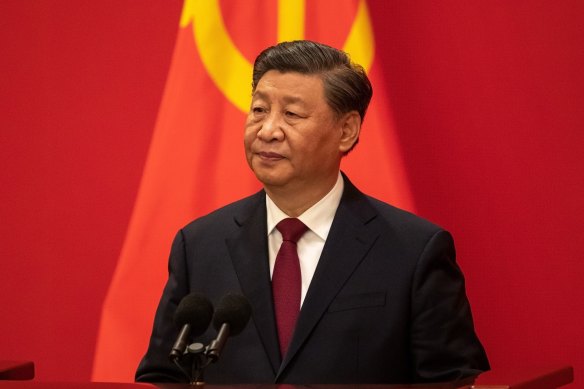This was published 1 year ago
Opinion
China is threatening to use its major trade weapon
Stephen Bartholomeusz
Senior business columnistIt hasn’t taken long for China to respond to the latest efforts by the US and the European Union to restrict its access to a key building block for technological supremacy.
After the Netherlands introduced a licensing regime for exports of the machines needed to produce the most advanced semiconductors on Friday, and amid reports that the US is again about to tighten its restrictions on exports of advanced chips to China, China’s Ministry of Commerce on Monday announced its own export restrictions.
Two key metals used in chip making, gallium and germanium, will now be subjected to export restrictions to “safeguard national security and interests”, the ministry said. Some applications for exports will need to be reviewed by China’s State Council, it said.

Xi Jinping’s regime has used China’s dominance of strategic minerals as leverage in the past.Credit: Bloomberg
China dominates the limited production of both metals, accounting for more than 90 per cent of the world’s supply of gallium and more than 80 per cent of the market for germanium.
These are highly strategic metals on the critical raw materials lists of the US, European Union, Australia and India. Each of those countries has developed its own list this year as they seek to shore up their supply chains for strategic resources and diversify away from an over-reliance on China.
Gallium is used in the advanced, high-performance chips used in mobile phones and electric cars, along with a host of other commercial and military applications. Germanium is used to upgrade the performance of silicon and is used in fibre optics and solar cells, among other applications.
There’s an element of mutually assured destruction if China fires the big gun – the dominance it has in a range of strategic raw materials – in its trade war arsenal.
The metals aren’t rare, but relatively low prices and China’s dominance of their production – as part of a decades-long strategy to dominate critical minerals that has involved direct and indirect subsidies – has pushed most of the potential alternative producers out of the markets.
(Most gallium is a byproduct of alumina and zinc refining. Australia was briefly a gallium producer in the early 1990s, exporting the material to France from a French-owned plant close to Alcoa’s Pinjarra alumina refinery but, amid a global glut, the plant was closed down after only a year.)
China’s decision to put the metals on the list of exports requiring permits isn’t unexpected.
It has always been obvious that the only significant response China could make to the US-led attempt to throttle its access to the advanced chips critical to most advanced commercial and military technologies was to use its dominance of a range of critical minerals as leverage.
Withholding supply
Implicit in the decision to create a licensing regime for some critical metals is the threat of withholding their supply.
It may, or may not, be a coincidence, but the announcement of the export curbs was made just ahead of Thursday’s arrival in China of US Treasury Secretary Janet Yellen.
Yellen is seeking to take some of the heat out of the relationship between the US and China and to reassure Chinese officials that the US is looking to de-risk its supply chains rather than completely decouple its economy from China’s.

The export curbs were announced just ahead of Thursday’s arrival in China of US Treasury Secretary Janet Yellen.Credit: AP
China has signalled that it wants to open a discussion on export controls, which at the moment are quite one-sided given that China has few options – other than threatening to cut off access to strategic raw materials – for countering the restrictions on exports of strategic technologies imposed by the US and an expanding range of US allies.
China has used its dominance of strategic minerals as leverage in the past, weaponising its control of rare earths, for instance, in territorial disputes with Japan, and has hinted at deploying that dominance in its wider trade disputes with the US.
In the near term, while shutting down US and/or European access to strategic metals like gallium and germanium would damage Western countries’ semiconductor industries and their ability to create advanced chips for commercial and military applications, it could also damage China’s own industries by inviting even more trade sanctions.
There’s an element of mutually assured destruction if China fires the big gun – the dominance it has in a range of strategic raw materials – in its trade war arsenal.
The longer-term risk for China is that over-playing its hand will ultimately see that dominance threatened by encouraging alternate sources of supply.
Australia’s reserves
Joe Biden’s Inflation Reduction Act is partly aimed at doing just that, offering major subsidies and tax incentives in an attempt to boost the supply of what’s needed for clean energy and other technologies from US domestic producers and from trusted allies such as Australia.
Australia has reserves of many of the critical minerals on America’s list (and of the list that the EU produced in March) and is well-placed to supply them.
It will probably require some form of subsidies if Australia, or other non-China producers of rare earths or strategic metals like gallium and germanium, are to compete with China, which has the scale, the low-cost base and its own subsidies to keep prices relatively low and price others out of the market.
The markets for metals like gallium are small, but they are growing rapidly as the sales of chips using the metals explode over the next decade. The volume of chips using gallium, for instance, is expected to be about eight times larger at the end of this decade than it was at the beginning.
If China were to immediately shut off access to gallium and germanium, it would have a significant impact on the near-term ability of the US and others to produce advanced semiconductors, at least in the volumes anticipated.
In the longer term, access to supplies from non-Chinese producers would almost inevitably result in higher-cost supply, although the expected steep increases in demand would have an impact on price and on the viability of non-Chinese production regardless of any Chinese restrictions on exports.
The next few years are going to be tricky as the US, Europe and their allies seek to reduce their dependence on China for strategic resources.
China will want to try to protect positions in key resources that it has been building for decades and which give it a level of countervailing power in trade confrontations with the US.
After the pandemic exposed global supply chain vulnerabilities and the Russian invasion of Ukraine highlighted the risk of over-dependence on a single supplier, however, there are irresistible arguments for diversification of the supply chain for resources deemed critical to national interests, regardless of the friction that the process generates.
The Business Briefing newsletter delivers major stories, exclusive coverage and expert opinion. Sign up to get it every weekday morning.